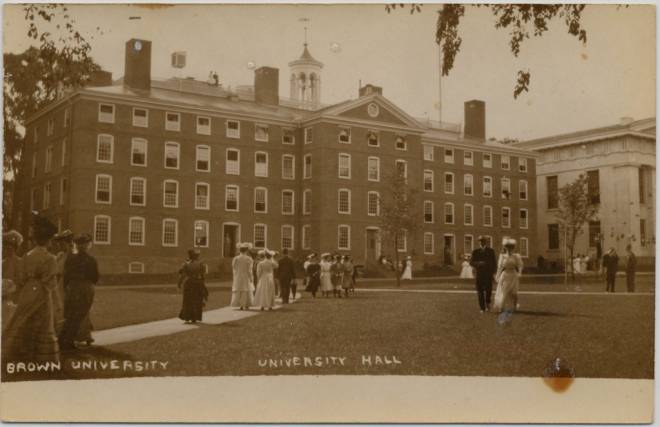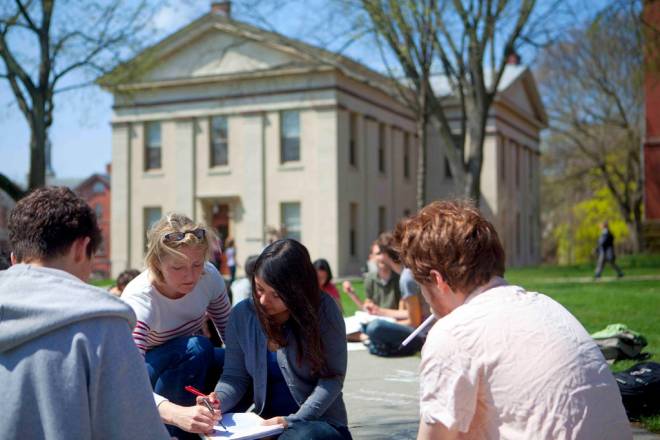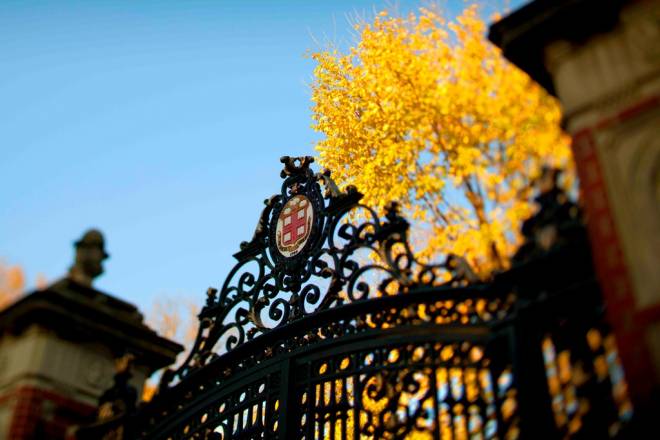





In the Beginning
The population of bustling Newport dwarfed that of Providence. The First Baptist Church in America was housed in a small meeting house, its landmark steeple not yet built. Independence from England was more than a decade away.
Much of today’s Rhode Island did not yet exist in 1764. But that was the year the colony’s leaders met to establish its very first college, the school we know today as Brown University. Brown is celebrating its 250th anniversary this year, beginning with a two-day launch party this month.
Of course, the Brown of 250 years ago looked just as different from today as the rest of Rhode Island. The school opened with a single student, growing to seven by its first commencement. They attended class in Warren, not moving to College Hill until 1770. Not even the name was the same – Rhode Island College became Brown University in 1804, in recognition of a much-needed donation. The university’s guiding principles, however, date back to the charter and its authors, administrators say.
Founded by Massachusetts exile Roger Williams as an early haven of religious tolerance, Rhode Island fast earned a reputation for independence and lively debate. The colony’s leaders wrote that spirit into their college: the charter specifies that differences of religious opinion won’t dictate classroom instruction, and the first commencement featured a debate on the hot- button question of American independence.
The Big Celebration
Brown’s 250th anniversary plans emphasize the school’s “long, deep shared history with Providence and Rhode Island,” says Marisa Quinn, vice president for public affairs and university relations. “Brown was founded in Rhode Island and we share many of the same values, based on freedom of conscience and independence,” Quinn says. Organizers see the celebration as an “opportunity to remind people of that.”
To reinforce those ties and the school’s educational mission, the semiquincentenary celebration – say that five times fast – opens with an event for Rhode Island middle schoolers. On Friday, March 7, about 300 seventh and eighth graders from 37 schools around the state will arrive on campus for “a taste of Brown,” Quinn says. They’ll attend workshops with Brown faculty and grad students on a diverse array of topics, including poetry, brain mapping, robots and Sanskrit.
The kids will also meet university President Christina Paxson, see student groups perform and eat lunch with current students in the Sharpe Refectory, more commonly known by its dubious nickname “The Ratty.” The goal, according to Quinn, is both to introduce Brown and to get the students “to start thinking about their own experience of higher education.”
The rest of that weekend will be a kind of open house writ large, with lectures, workshops, performances and exhibits designed to showcase the many faces of an institution that prides itself on the diversity of its offerings and the range of choices made possible by its trademark open curriculum. And like any good party, there will be dessert. On Friday night, visitors will enjoy a giant cake in the shape of University Hall, Brown’s first building.
“Every Rhode Islander, frankly, is invited to campus,” says Quinn. “We hope that residents of Providence and Rhode Island will come to campus and get a sense of the range of talent and performance that Brown can offer.” She says that in addition to showcasing Brown, she hopes the events can help remind Rhode Islanders of the resources available at all the state’s colleges.
Throughout the coming year, the school will continue to celebrate with special programming at the 2014 and 2015 commencement ceremonies, a special WaterFire during Family Weekend in October and a website featuring an interactive timeline of Brown’s history. A book of essays and perspectives by 50 Brown alumni, called The Brown Reader, is due out in the spring. Essayists include literary giants like novelists Jeffrey Eugenides, Lois Lowry, Rick Moody, Marilynne Robinson and Meg Wolitzer; playwright Sarah Ruhl; and venerable Providence newspaperman Charlie Bakst.
Working Within the Community
The festivities come as community and university leaders alike praise the school’s relationship with the city. “It’s a great partnership,” says Allison Spooner, president of the College Hill Neighborhood Association. “We work collaboratively, we have open discussions about any issues.” Brown’s Executive Vice President for Planning and Policy, Russell Carey, agrees. “Everybody works hard to make it work,” he says.
East Side residents have always had a close relationship with the University. While occasionally adversarial in the past - the building of the Life Sciences Building comes to mind - more typical are the celebratory events that spill over from the campus and bring town and gown together. Football games at Brown Stadium, crew races on the Seekonk, the campus dance, Brown-sponsored Waterfires, summer theatre, and of course the Memorial Day weekend graduation festivities reinforce Brown’s unique ability to add vitality to the community.
For the last decade, the school has held monthly meetings with representatives from CHNA, the neighborhood associations of Fox Point and the Jewelry District, Moses Brown and Wheeler schools and other groups from the community. “A monthly meeting seems like a small thing,” Carey says, “but it’s how you build relationships and understanding and a sense of what different groups’ goals are.”
Those relationships between Brown and its neighbors have improved in recent years. In her five years with CHNA, Spooner says the school and community have worked closely and well together. But, she says, there have been “times in the past where Brown was viewed as working more independently without looking at the community as a whole.”
According to Quinn, that complaint reflects the way the school used to approach planning. For the neighbors, there “wasn’t a sense of what Brown’s long-term plans were,” she explains, “and frankly there weren’t, as far as I know, plans for the long- term growth of the university.”
Looking Towards the Future
By contrast, the Campaign for Academic Enrichment, launched in 2005 and known as “Boldly Brown,” and the strategic plan launched last year both emphasize the long term. Those initiatives have been especially clear on “how plans actually manifest themselves in [Brown’s] physical growth,” Quinn says, which is key for the school’s neighbors.
Carey sees the expanding engineering program, recently elevated to the Brown University School of Engineering, as a prime example of the more comprehensive planning of recent years.
The engineering school will need more space as it expands, he explains. But because of the freedom offered by Brown’s open curriculum, engineering students tend to take a wide range of classes outside their department – in history, literature, foreign language, anthropology, art – and those disciplines remain concentrated at the main campus on College Hill. The School of Engineering couldn’t move to, say, the newer campus in the Jewelry District without cutting students off from all those options.
So the engineering school will stay, and grow, on College Hill. That will mean expanding its current facilities, which already take up much of a block between Brook and Hope Streets.
 Brown and its neighbors are poised to plan that expansion together. Already, Spooner says, the school has sought input from College Hill residents, businesses and other groups on the project. She hopes ongoing public meetings will “make sure everyone has the opportunity to have their voice heard.”
Brown and its neighbors are poised to plan that expansion together. Already, Spooner says, the school has sought input from College Hill residents, businesses and other groups on the project. She hopes ongoing public meetings will “make sure everyone has the opportunity to have their voice heard.”
Enhancing the engineering school is just one piece of the university’s future outlook, as outlined in last year’s strategic plan – one of the areas in which Brown is “building on strengths that exist,” according to Carey. The school also plans to improve its financial aid by offering support for summer internships, further diversify course offerings and better facilitate faculty research, among numerous other initiatives.
The strategic plan calls for investment in areas that are “important to society.” They are topics, Carey explains, where “focused investment can make a difference.”
The focus areas span the disciplines of humanities, sciences and the arts, from “cultivating creative expression” and “exploring human experience” to “understanding the human brain” and “deciphering disease and improving population health.”
Some areas, like “sustaining life on Earth,” are inherently interdisciplinary. On that topic, the school plans to combine scientists’ work on environmental change with the humanities’ understanding of how people interact with their environment. The goals are wide-reaching, from developing environmental policy to exploring the ethics of sustainability.
Brown is also looking to make better use of technology, Carey says.
Technology and the Internet are already central to life at Brown, like anywhere else. Registration is online, along with many course materials, from syllabi and study guides to audio and video clips that complement the reading. In many classes, students respond to questions not by raising their hands but by pressing the buttons on digital clickers.
But a good deal of academic life happens much as it did, if not 250 years ago, at least for the last century or more: students buy books at the bookstore, take notes at desks in the lecture halls and do their work in the libraries.
Administrators are looking at ways that technology could change some of those fundamentals. It’s important, Carey says, that the school “stay true to its mission as a residential academic community,” but technology offers new opportunities all the same.
Brown has tried some pilot courses online, in which tens of thousands of people took part all around the world, according to Carey. Some courses have experimented on campus as well. A microeconomics class tried the flip-classroom approach, with lectures posted online so class time could focus on small group discussion and problem solving. These ideas are “new to everyone,” says Carey. “We’re trying to identify the best ways to take advantage of them.
It’s safe to assume Brown University’s founders never imagined students would one day take classes from halfway around the world and hear lectures from the comfort of their dorm rooms. They probably never envisioned a co-ed school with more than 8,600 undergraduate, graduate and medical students hailing from every corner of the globe nearly every rung of the social ladder, either – though perhaps the colonists dreamed big.
But a school striving to become ever more diverse, whose students crafted their own open curriculum, where fierce and informed debate rages over every issue imaginable and planners increasingly collaborate with the community at large? It all sounds rather like the “tumultuous amity” one historian described of Brown’s and Rhode Island’s earliest days
Comments
No comments on this item Please log in to comment by clicking here